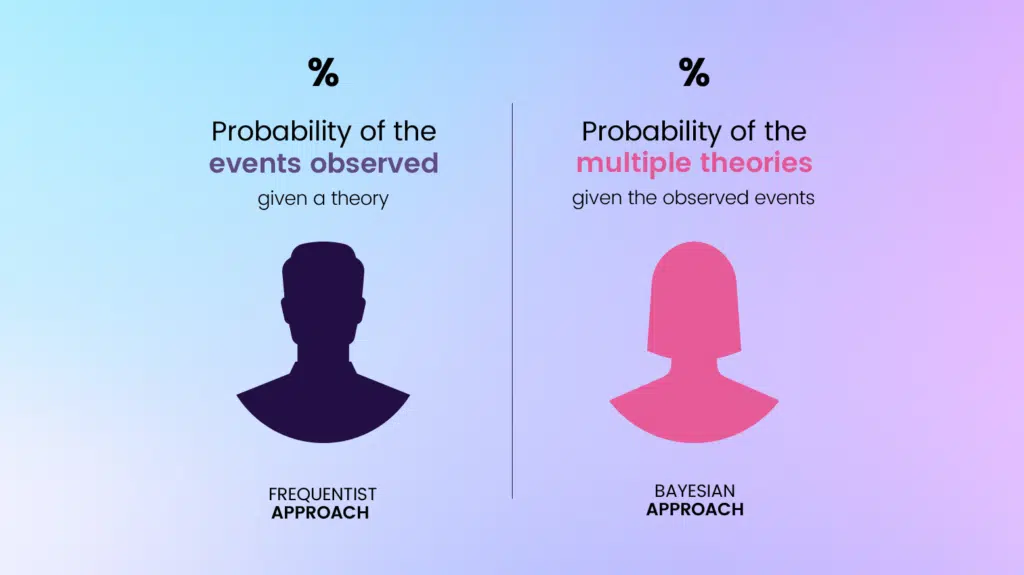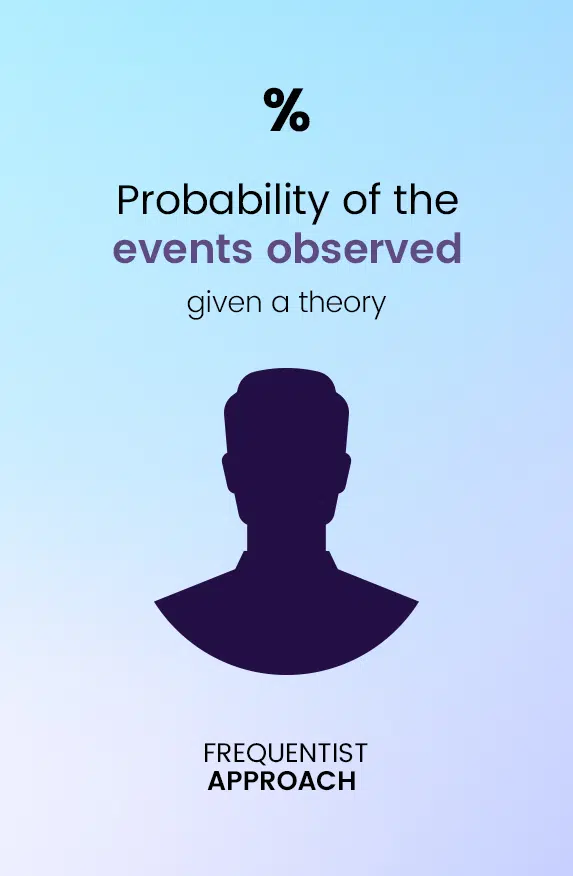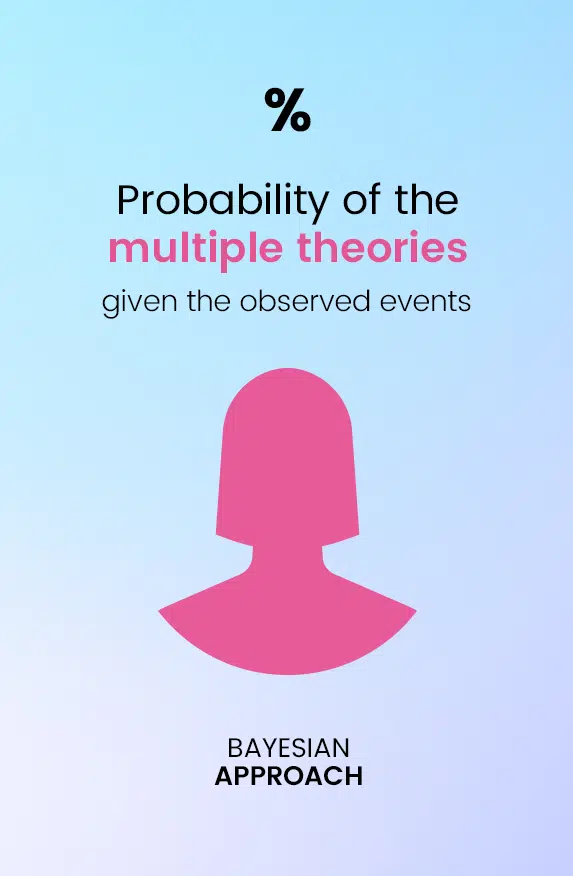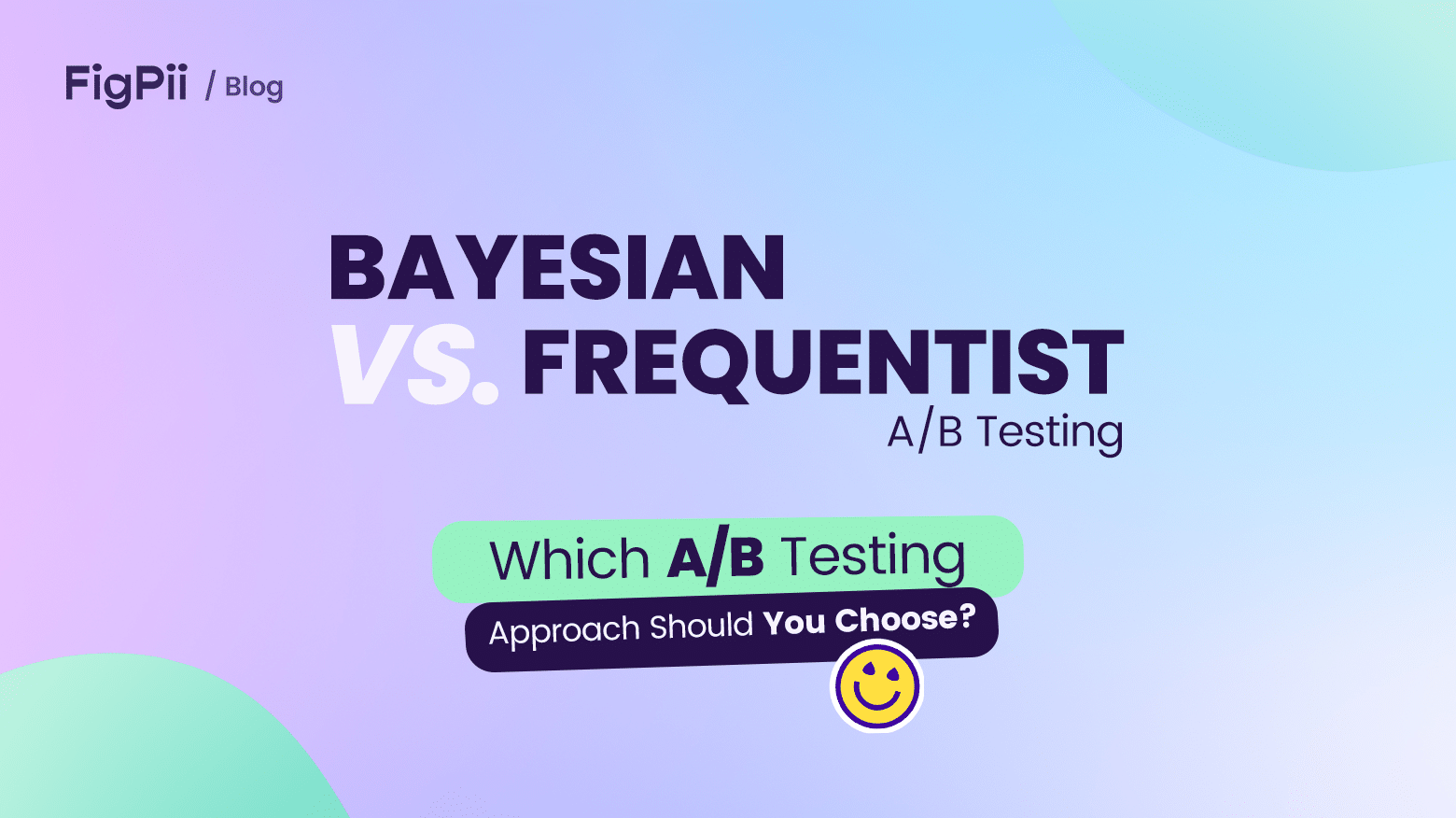Imagine a fever patient visiting two doctors – one Bayesian, the other Frequentist. The Bayesian doctor considers the patient’s symptoms in the context of their medical history and previous similar cases, adapting their diagnosis as more information becomes available.
In contrast, the Frequentist doctor focuses strictly on the current symptoms and test results without factoring in past data or external information.
This scenario is similar to A/B testing in conversion rate optimization, where two main statistical approaches – Bayesian and Frequentist – offer different paths to understanding and optimizing user experiences.

Just as with our doctors, the choice between Bayesian and Frequentist methodologies can significantly influence the outcome of an A/B test.
The Frequentist Approach To A/B Testing
The Frequentist approach to A/B testing is a classic method grounded in straightforward statistical analysis. It’s defined by its focus on data from the current experiment, emphasizing hypothesis testing and p-values without leaning on past data or external information.

At the core of this approach is the concept of hypothesis testing. In A/B testing, this typically starts with a null hypothesis, which assumes no significant difference between the variants being tested.
The objective is to either reject this hypothesis or not based on the data gathered from the experiment. The p-value plays a crucial role here. It measures the probability of observing the experiment’s results, or more extreme, assuming the null hypothesis is true.
A low p-value (commonly below 0.05) suggests that the differences observed in the test are statistically significant, leading to the rejection of the null hypothesis.
Its precise and data-focused nature makes the Frequentist approach a go-to choice in many A/B testing scenarios. It provides direct answers based on the experiment’s data, indicating whether there is substantial evidence to show that one version outperforms the other.
Pros Frequentist Approach To A/B Testing
-
Simplicity and Clarity
One of the most significant advantages of the Frequentist approach in A/B testing is its simplicity and clarity. This method is straightforward – it revolves around setting up a hypothesis and testing it directly against the data collected. There’s no need for complex statistical models or the integration of external data.
-
Precision with Large Data Sets
The Frequentist approach excels when dealing with large data sets. This method can provide highly precise results in scenarios where you have a substantial amount of data.
The reason for this effectiveness is that larger sample sizes reduce the margin of error and increase the reliability of the test outcomes.
This precision is crucial in making informed decisions, especially in high-stakes testing scenarios where the slightest improvement or decline in performance can have significant implications.
-
Objectivity
Another key strength of the Frequentist approach is its objectivity. This method relies solely on the data at hand without being influenced by past results or subjective beliefs.
It treats each experiment as unique, making decisions based purely on empirical evidence gathered during testing.
Cons Frequentist Approach To A/B Testing
-
Limitations with Small Data Sets
One of the primary drawbacks of the Frequentist approach is its limitations when dealing with small data sets. In scenarios where the data is limited, such as with a smaller website audience or a short testing period, the Frequentist approach may struggle to provide reliable insights.
The lack of data can lead to a higher margin of error, making it challenging to draw confident conclusions from the test results.
-
Lack of Flexibility
The Frequentist approach is often criticized for its lack of flexibility. It operates on a fixed hypothesis testing model, where the experiment is designed to either reject or fail to reject the null hypothesis based on the data collected.
This rigidity means that adapting an experiment to account for new trends, unexpected changes, or additional insights becomes difficult once an experiment is underway.
-
Potential for Misinterpretation
Another significant concern with the Frequentist approach is the potential for misinterpretation, particularly regarding p-values and statistical significance.
P-values are often misunderstood, leading to incorrect conclusions about the effectiveness of a tested variant.
For instance, a low p-value doesn’t necessarily mean that the variant has a substantial practical impact; it simply indicates that the observed difference is unlikely to be due to chance.
The Bayesian Approach To A/B Testing
The Bayesian approach to A/B testing represents a more dynamic and fluid methodology compared to the traditional Frequentist method. Central to this approach is the concept of incorporating prior knowledge and continuously updating beliefs based on incoming data.

Unlike the Frequentist approach, which relies solely on data from the current experiment, the Bayesian method starts with a prior belief or hypothesis. This prior is then adjusted as new data is collected, allowing for a more nuanced and evolving understanding of the test results.
At the heart of the Bayesian approach is integrating past data and real-time information. This method doesn’t just look at the data from the current experiment in isolation. Instead, it considers historical data, previous experiments, and relevant external information.
This comprehensive view enables a more informed starting point for each test and allows for adjustments as more data becomes available.
The Bayesian method provides a more holistic view of customer behavior and preferences, leading to more accurate and actionable insights.
Pros of The Bayesian Approach To A/B Testing
-
Ability to Update Hypotheses Based on New Data
A standout advantage of the Bayesian approach in A/B testing is its inherent flexibility, particularly in updating hypotheses as new data becomes available.
Unlike the Frequentist method, which is more static and bound to initial hypotheses, the Bayesian approach allows for a dynamic testing process. As the test progresses and new data points are collected, the Bayesian method adapts and refines the hypothesis.
-
Strength in Scenarios with Less Data
Bayesian methods shine in scenarios where data is limited. This strength is particularly relevant for small businesses or new websites with lower traffic, where gathering large data sets for A/B testing can be challenging. The Bayesian approach can effectively work with smaller sample sizes because it incorporates prior knowledge or beliefs into the analysis.
-
Intuitive Understanding for Non-Statisticians.
The Bayesian approach produces results that are more intuitively understood by those without a deep background in statistics.
This is because it provides probabilities that directly answer questions like “What is the likelihood that version A is better than version B?” These probabilistic results are often easier for non-statisticians to grasp compared to p-values and confidence intervals used in the Frequentist approach.
Bayesian results offer a clearer and more straightforward interpretation for decision-makers in marketing or business who may not be well-versed in statistical jargon.
Cons of The Bayesian Approach To A/B Testing
-
Complexity in Understanding Bayesian Probabilities
While the Bayesian approach offers intuitive results, the underlying mechanics of understanding Bayesian probabilities can be complex.
The method involves concepts like prior distributions, likelihood functions, and posterior probabilities, which can be challenging to grasp without a solid statistical background.
-
Influence of Prior Beliefs or Data
A unique aspect of the Bayesian approach is its incorporation of prior beliefs or data into the analysis. While this is a strength in many scenarios, it also introduces a level of subjectivity.
The choice of prior can significantly influence the results, especially in cases with limited current data. If the prior is not chosen carefully or is based on biased or inaccurate information, it can lead to skewed results.
-
Need for More Computational Resources
The Bayesian approach can be computationally intensive, particularly for complex models or large datasets.
Continuously updating probabilities and recalculating posterior distributions as new data comes in requires significant computational power.
This can be a challenge for organizations with limited technical resources. Additionally, using advanced Bayesian models might require specialized software or tools, adding to the resource requirements.
Differences between The Bayesian and Frequentist Approach
Aspect |
Bayesian Approach |
Frequentist Approach |
|
Core Philosophy |
Based on probability and prior knowledge. |
Based on the long-term frequency of events. |
|
Data Utilization |
Incorporates prior data (previous experiments, historical data) and updates hypotheses with new data. |
Focuses solely on data from the current experiment without considering past data or external information. |
|
Flexibility |
Highly flexible, allowing for continuous updating of hypotheses. |
Less flexible, as it relies on predefined hypotheses and fixed sample sizes. |
|
Interpretation of Results |
Results are probabilistic, providing a range of possible outcomes and their likelihoods. |
Results are definitive, aiming to prove or disprove a hypothesis. |
|
Complexity |
Generally more complex due to the incorporation of prior data and probability distributions. |
Simpler in terms of data analysis, focusing on straightforward hypothesis testing. |
|
Suitability for Small Data Sets |
Effective even with smaller data sets due to its adaptive nature. |
It may be less effective with small data sets, often requiring larger samples for conclusive results. |
|
Subjectivity |
It can be more subjective, depending on the selection and interpretation of prior data. |
Objective, as it relies solely on empirical data from the current experiment. |
|
Computational Intensity |
It can be computationally intensive due to the need for continuous data analysis and updating of probabilities. |
Less computationally intensive, generally involving standard statistical tests and calculations. |
|
Common Misinterpretations |
Probabilities and Bayesian ‘beliefs’ can be misinterpreted or misunderstood. |
P-values and statistical significance can often be misinterpreted or misunderstood. |
|
Industry Trend |
Increasingly popular in digital marketing and industries where real-time data and adaptability are crucial. |
Traditionally dominant, especially in fields that rely on long-term, empirical data analysis. |
Bayesian vs. Frequentist A/B Testing: Which Should You Choose For A/B Testing
When choosing between the Frequentist and Bayesian approaches for A/B testing, the decision largely hinges on the specific context of your testing scenario, including factors like the size of your data, industry type, available resources, required expertise, and prevailing industry trends.
Here’s a detailed and practical guide to help you make an informed choice based on your needs.
-
Recommendations Based on A/B Testing Scenarios:
-
Size of Data
If you’re working with large datasets, the Frequentist approach might be more suitable due to its precision and simplicity in handling substantial data. In contrast, the Bayesian approach can be more advantageous if you’re dealing with smaller datasets or have limited data availability.
-
Industry Type
For industries where trends and consumer behaviors change rapidly, such as e-commerce or digital marketing, the Bayesian approach offers the flexibility needed to adapt to these changes. Its ability to update hypotheses in real time makes it ideal for dynamic environments.
On the other hand, industries that rely on long-term, consistent data analysis, like manufacturing or pharmaceuticals, may find the stability and objectivity of the Frequentist approach more fitting.
-
Complexity of Test
The complexity of your test and the outcomes you seek are crucial factors. Simple tests with binary outcomes are well-suited to the Frequentist approach, whereas more complex tests exploring nuanced user behaviors may benefit from the Bayesian method.
-
Practical Aspects to Consider
-
Resource Availability
The Bayesian approach often requires more computational power and sophisticated statistical software. If your organization has limited technical resources, the Frequentist approach might be more feasible with its less demanding computational needs.
-
Expertise Required
The Bayesian method can be complex and requires a deeper understanding of statistical modeling. If your team lacks this expertise, the more straightforward Frequentist approach could be better.
However, investing in training or hiring talent with Bayesian expertise could benefit organizations looking to leverage this approach’s adaptability and nuanced insights.
-
Project Scalability and Long-term goals
Scalability and long-term goals are also important. The Bayesian approach’s flexibility is advantageous if your project demands scalability and adaptability or aims to respond to market changes rapidly.
Conversely, the Frequentist approach is more appropriate for projects where scalability is less of a concern and consistency in testing methodologies is valued.
Final Verdict
The major difference between the Frequentist and Bayesian approaches to A/B testing is that the Frequentist method relies solely on data from the current experiment to validate a hypothesis, whereas the Bayesian method integrates both historical data and new information to update and adapt its hypothesis continuously.
Both approaches have their merits and limitations. The Frequentist approach offers simplicity, objectivity, and precision, which is particularly useful in straightforward, data-rich scenarios. With its flexibility and comprehensive data integration, the Bayesian approach is ideal for dynamic environments and scenarios with limited data.
Consider the nature of your A/B testing project, the resources at your disposal, and the level of statistical expertise within your team. There’s also the option of using a hybrid approach, leveraging the strengths of both methodologies to suit different aspects of your A/B testing strategy.

